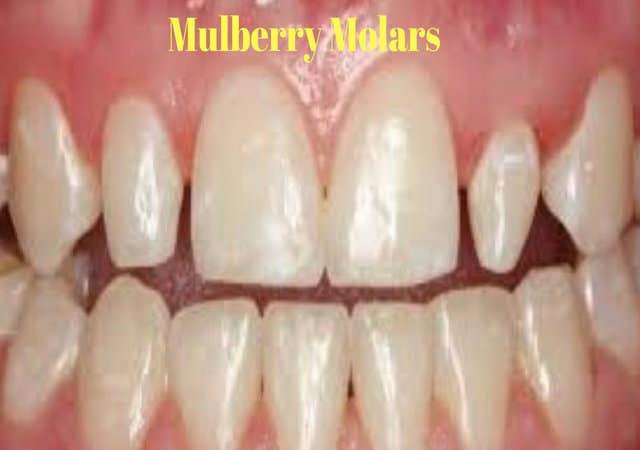Want to know about mulberry molars? You are landed on the perfect page.
If you want to know anything about mulberry molars from its symptoms and causes to its treatment then keep reading this article.

Table of Contents
What are Mulberry Molars?
Mulberry molars are a dental condition usually associated with congenital syphilis, characterized by multiple rounded rudimentary enamel cusps on the permanent first molars. Mulberry molars are physically defective permanent molars. The deformity is caused by congenital syphilis. This type of abnormality is characterized by dwarfed molars with cusps covered with globular enamel growths. These teeth are functional but can be cosmetically fixed with crowns, bridges, or implants.
Externally, they look like a normal tooth but the deformity is in the grinding area. The size diminishes creating a stumpy version of the molar.
Mulberry Molar Symptoms
It has the following distinct and visible symptoms:
- Deformity of permanent Molars
- The pit is completely absent, in some cases shallow
- Grinding Surface is corrupted
Causes of Mulberry Molars
Congenital Syphilis is the most common cause of mulberry molars. It is a hereditary disease and passes from mother to fetus during pregnancy and chances are also that it runs in the family.
This condition is present by birth but shows off only after the permanent teeth have come out.
Some other causes include:
- Enamel Hypoplasia
- Deficiency in Tooth Enamel
- Urinary Tract Disease
- Cold
- Hypoglycemia
- Late Congenital Syphilis
Treatment of Mulberry Teeth
Mulberry Molars are usually smaller in size than normal molars. In this condition only the enamel is defective and the rest of the part including roots is normal.
Mulberry Molars don’t require any special treatment, you just have to visit a dentist to improve the appearance of the teeth.
But,
In a severe form of cusp deformities, more thorough treatment is necessary. And, here I am going to tell you the 3 Treatment procedures for this:
- Dental Crown
- Dental Bridge
- Tooth / Dental Implant
Let’s discuss them in detail for a thorough understanding.
1. Dental Crown
In this treatment procedure, bonds and veneers both are used as a dental crown to cover the front side of Mulberry Molars. The dental crown is a typical treatment method for the mulberry tooth which does not harm the tooth.
In severe cusp deformities, dental replacement is the only option left.
2. Dental Bridge
In this, two dental crowns are applied that are linked via a bridge. Dental Bridge is a more suitable option than a dental implant because it is reversible.
On the other hand, if your natural tooth is damaged or missing then the dental bridge is not a suitable option.
3. Dental Implant
When there is no treatment option left then the dental implant is the only option. In this, the whole tooth is replaced by the dentist.
The Bottom Line!
Lastly, I would like to say that if you notice any symptoms of mulberry molars and you want to treat it then visit your dentist as he or she can tell you exactly about the severity of the condition and which treatment procedure should be taken.
Articles You May Like:
- 21 Proven Ways to Whiten Teeth Naturally at Home in 1 Day
- 17 Effective Ways to Get Rid of Bad Breath Permanently and Fast
The information present on this webpage has not been evaluated by any medical authority such as the Food & Drug Administration (FDA). All information is for educational purposes only. Strictly saying, we do not aim to diagnose, treat, cure, or prevent any disease or illness. You must consult a medical professional before acting on any content on this website.
Usama is a medical student (MD) and loves to share his medical knowledge. He loves to write on different health and medical conditions for a better understanding of a common person. To know more about him visit the About page.
